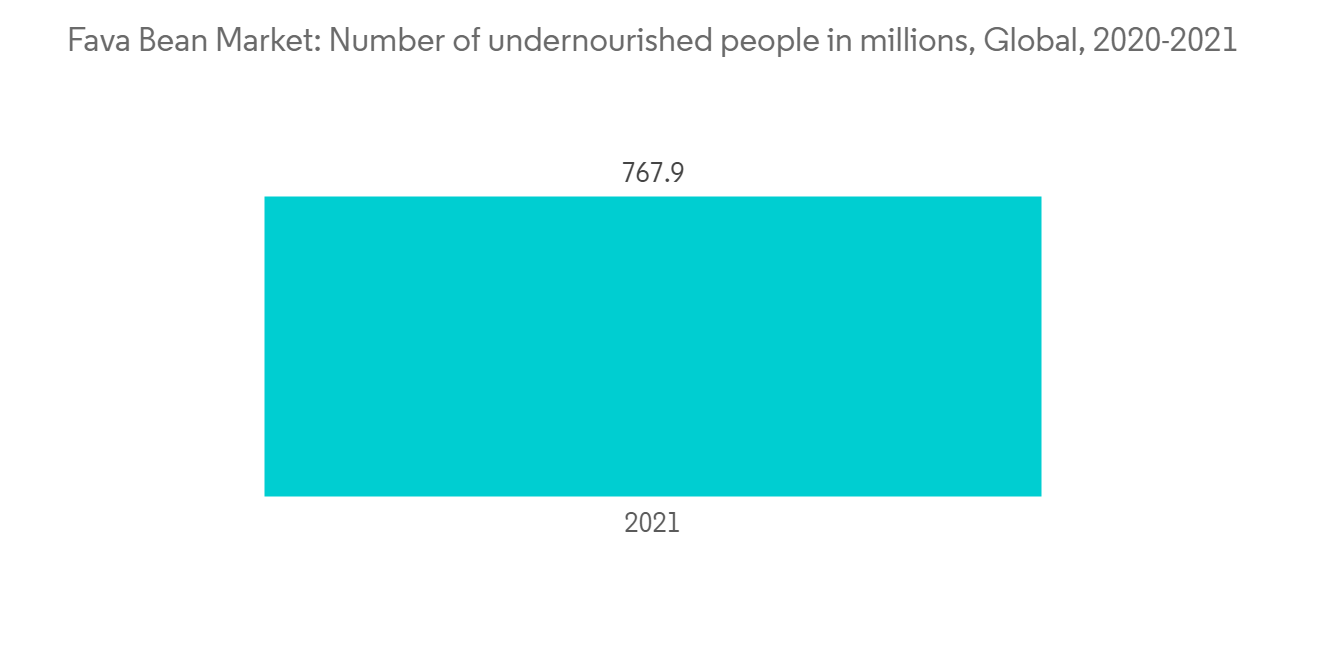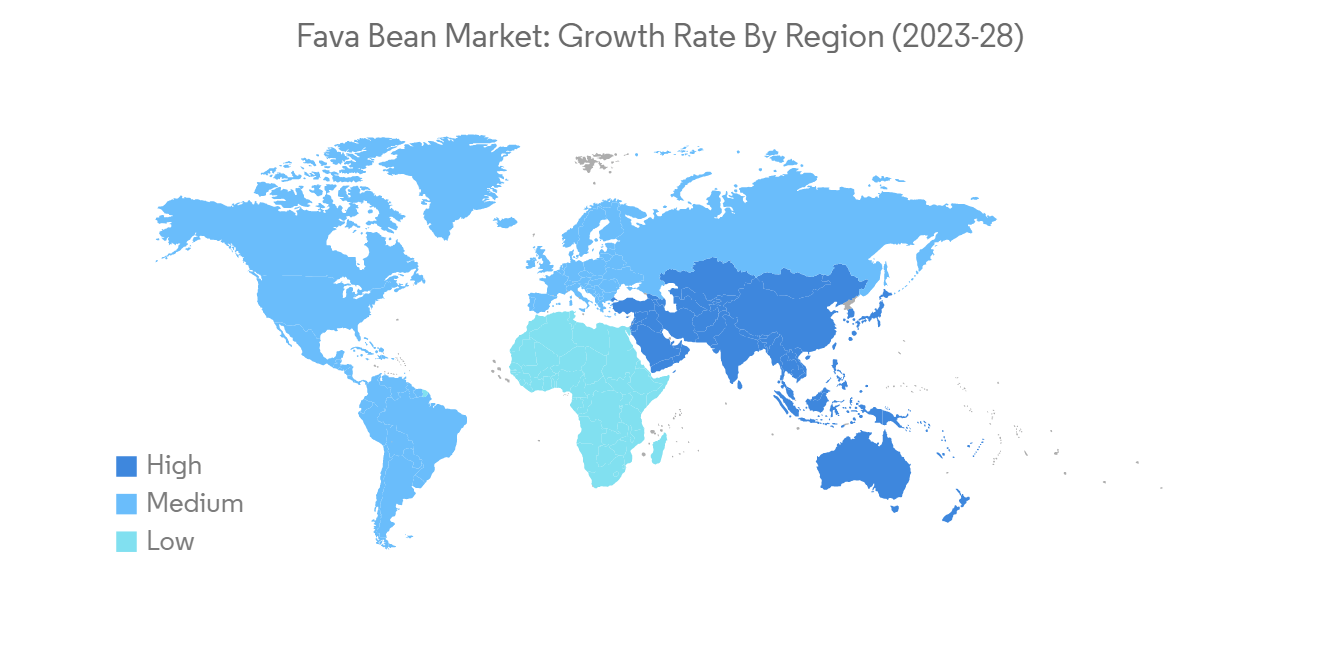 |
市場調査レポート
商品コード
1273325
ソラマメ市場 - 成長、動向、影響、予測(2023年-2028年)Fava Bean Market - Growth, Trends, and Forecasts (2023 - 2028) |
||||||
● お客様のご希望に応じて、既存データの加工や未掲載情報(例:国別セグメント)の追加などの対応が可能です。 詳細はお問い合わせください。
価格
| ソラマメ市場 - 成長、動向、影響、予測(2023年-2028年) |
|
出版日: 2023年04月14日
発行: Mordor Intelligence
ページ情報: 英文 100 Pages
納期: 2~3営業日
|
ご注意事項 :
本レポートは最新情報反映のため適宜更新し、内容構成変更を行う場合があります。ご検討の際はお問い合わせください。
- 全表示
- 概要
- 目次
概要
ソラマメの世界市場は予測期間中に4.0%のCAGRで推移すると予測されています。
主なハイライト
- 健康的なライフスタイルと栄養価の高い食事への関心の高まりによる、ソラマメの消費量の増加が市場を牽引しています。ソラマメは、タンパク質、食物繊維、炭水化物の良い供給源です。また、カルシウム、鉄、マグネシウムなどのミネラルが豊富に含まれています。健康的な食生活の動向を通じて健康的なライフスタイルを維持しようとする動きや、ソラマメに関連する利点に関する意識の高まりが、市場の成長を促しています。
- ソラマメは、健康的でバランスの取れた食事に最適で汎用性の高い食材であるため、中東やアジアの料理でさまざまなレシピに使われることが増えています。また、ベジタリアン志向の高まりも、今後数年間におけるソラマメの消費を促進すると予想されます。ソラマメは、血圧の維持、免疫システムの強化、骨の健康増進に効果的とされています。また、ソラマメの強力粉はパンやパスタの製造にも使用されており、これが世界のソラマメ市場を牽引しています。ソラマメの価格が継続的に変動することが、世界のソラマメ市場の成長を妨げています。
- ここ数年、欧州や米国では菜食主義の傾向が強まっており、世界中に広がっています。さらに、人々は植物性の食事に注目しており、これがソラマメの消費量を増加させる要因となっています。動物性タンパク質は、コレステロール値や脂質、カロリーが高く、心疾患や高血糖、肥満などのリスクを高める。そのため、人々は菜食主義者のタンパク源に傾倒しているのです。
ソラマメの市場動向
栄養価の高い食品への需要の高まり
- 栄養価の高さと組織小売業によるソラマメの入手のしやすさが、世界のソラマメ市場の主な促進要因の1つとなっています。世界中の健康的な食事の動向は、栄養素を豊富に含む食品の消費を促進しています。そのため、健康志向の高い消費者の間でソラマメの需要が増加しており、世界のソラマメ市場の成長を促進しています。
- また、赤身肉に関連する心血管障害に対する懸念の高まりから、世界レベルで菜食主義者の人口が急速に増加しており、今後も市場にとって有利な要因になると予想されます。また、ソラマメは豊富なタンパク質源と考えられており、フィットネス志向の高い消費者からの需要が高まっています。
- 肉食の減少に加え、世界的に有機食品への関心が高まっていることから、人々は健康志向を強め、タンパク質源を動物性から植物性へと切り替えつつあります。このような背景から、欧州連合(EU)は温室効果ガス削減のための長期戦略を策定しました。欧州ベジタリアン連合(EVU)は、EU委員会に対し、気候政策の中で動物性食品の生産を制限するよう働きかけています。また、欧州連合は、社会的な食生活の移行を支援する戦略を実施するよう、意思決定者に働きかけています。

アジア太平洋地域が市場を独占する
- 世界的に見ると、アジア太平洋はソラマメの主要生産地です。アジア太平洋では、2021年に乾燥ソラマメと生ソラマメが270万トンを占め、世界のソラマメ生産量の35.3%を占めました。アジア太平洋におけるソラマメの総生産量は、2019年に250万メートルトンでしたが、2021年には270万メートルトンに増加しました。生産量の増加は、栄養価の高さによる消費者需要の増加や高い輸出の可能性に関連しています。
- この地域では中国が主要な生産国となっています。中国のソラマメ生産量は、2021年に190万メートルトンでした。中国は2021年の同地域のソラマメ生産量の69.1%を占めています。ソラマメは四川料理で広く使われており、中国語では四川豆と呼ばれています。野菜としてだけでなく、調味料としても利用されています。インドや近隣諸国では、低脂肪のスナックとして炒った種子の消費が伸びていることが、この地域の需要を促進する要因のひとつとなっています。
- 中国国内では、マメ科の作物の採算が悪化し、栽培面積や生産量が減少しています。一方、健康食品としての植物性マメ科植物に対する消費者ニーズの高まりにより、魅力的な市場価格と国内の生産量の急激な増加が見られます。生育期間が短く、生物学的窒素固定(BNF)という利点を持つ豆類は、この地域の作付システムにおいて重要な役割を担っています。理想的な間作として、作物の収量を増やし、増加する食糧需要に対応するための間作システムの経済的利益を高めることができます。

ソラマメの産業概要
その他の特典:
- エクセル形式の市場予測(ME)シート
- 3ヶ月間のアナリストサポート
目次
第1章 イントロダクション
- 調査の前提条件と市場定義
- 本調査の対象範囲
第2章 調査手法
第3章 エグゼクティブサマリー
第4章 市場力学
- 市場概要
- 市場促進要因
- 市場抑制要因
- バリューチェーン分析
第5章 市場セグメンテーション
- 地域(生産分析、金額・数量による消費分析、金額・数量による輸入分析、金額・数量による輸出分析、価格動向分析)
- 北米
- 米国
- カナダ
- メキシコ
- 欧州
- ドイツ
- 英国
- フランス
- ロシア
- スペイン
- スウェーデン
- イタリア
- アジア太平洋地域
- 中国
- 日本
- オーストラリア
- イラン
- 南米
- アルゼンチン
- ペルー
- ブラジル
- アフリカ
- エチオピア
- エジプト
- スーダン
- モロッコ
- 北米
第6章 市場機会と将来動向
目次
Product Code: 67551
The global fava bean market is projected to register a CAGR of 4.0% during the forecast period.
Key Highlights
- The market is being driven by the increasing consumption of fava beans owing to the rising interest in adopting a healthy lifestyle and nutritious diet. Fava beans are a good source of protein, fiber, and carbohydrates. In terms of mineral content, fava beans are rich in calcium, iron, and magnesium, among others. The drive towards maintaining a healthy lifestyle through healthy eating trends and increasing awareness about the benefits associated with fava beans has spurred market growth.
- Fava beans are increasingly used in various recipes across Middle Eastern and Asian cuisines as they are an excellent and versatile addition to a healthy, balanced diet. In addition, the rising trend of vegetarianism is also anticipated to bolster the consumption of fava beans in the coming years. Fava beans are considered effective in maintaining blood pressure, boosting the immune system, and improving bone health in the human body. Fava bean flour is also used in the production of bread and pasta, which drives the global fava bean market. Continuous volatility in fava beans prices hinders the growth of the global fava beans market.
- For the past few years, there has been an increasing trend of veganism in Europe and the United States, spreading worldwide. Moreover, people are focused on plant-based diets, which has been the reason for the higher consumption of fava beans. The intake of animal protein, which is associated with high cholesterol levels, fat, and calories, increases the risk of cardiac diseases, high blood sugar levels, and obesity. Hence, people are showing an inclination toward vegan sources of protein.
Fava Bean Market Trends
Growing Demand for Nutritional Food
- The high nutritional benefits and increased availability of fava beans through organized retailing have been one of the primary drivers of the global fava bean market. Healthy eating trends around the world are promoting the consumption of foods that are rich in nutrients. Thus, the demand for fava beans is increasing among health-conscious consumers, thereby promoting the growth of the global fava beans market.
- The rapidly growing vegan population on a global level due to increasing concerns regarding cardiovascular disorders associated with red meat is expected to remain a favorable factor for the market. These beans are considered a rich protein source, resulting in increased demand from fitness-conscious consumers.
- In addition to the decline in meat consumption, people are becoming health-conscious and switching their protein sources from animal-based to plant-based, as there are increasing concerns about organic food worldwide. Owing to this, the European Union developed a long-term strategy to reduce greenhouse gas emissions. The European Vegetarian Union (EVU) encourages the EU commission to limit the production of animal products within its climate policy. The European Union also encourages decision-makers to implement strategies to support the societal dietary transition.

Asia-Pacific Dominates the Market
- Globally, Asia-Pacific is the primary producer of fava beans. In Asia-Pacific, dry and green fava beans accounted for 2.7 million metric tons in 2021, which occupied 35.3% of the global fava bean production. The total fava bean production in Asia-Pacific was 2.5 million metric tons in 2019 which increased to 2.7 million metric tons in 2021. The increase in production is associated with increasing consumer demand and high export potential due to its nutritional value.
- China is the major producing country in the region. The fava bean production in China was 1.9 million metric tons in 2021. China accounted for 69.1% of the region's fava bean production in 2021. Fava bean is widely used in Sichuan cuisine and is called Sichuan beans in Chinese. It is used as a vegetable and also as a seasoning. Growing consumption of roasted seeds as a low-fat snack in India and neighboring countries is among the factors driving demand in the region.
- With reduced profits for food legume crops, their area and production have decreased within China. At the same time, the rising consumer demand for vegetable food legumes as a healthy food has led to attractive market prices and sharp increases in production within the country. With the advantages of short growing periods and biological nitrogen fixation (BNF), legumes are playing an important role in the cropping systems in the region. As ideal intercrops, it can increase crop yields and the economic benefits of the intercropping systems to meet the increasing demand for food.

Fava Bean Industry Overview
Additional Benefits:
- The market estimate (ME) sheet in Excel format
- 3 months of analyst support
TABLE OF CONTENTS
1 INTRODUCTION
- 1.1 Study Assumptions and Market Definition
- 1.2 Scope of the Study
2 RESEARCH METHODOLOGY
3 EXECUTIVE SUMMARY
4 MARKET DYNAMICS
- 4.1 Market Overview
- 4.2 Market Drivers
- 4.3 Market Restraints
- 4.4 Value Chain Analysis
5 MARKET SEGMENTATION
- 5.1 Geography (Production Analysis, Consumption Analysis by Value & Volume, Import Analysis by Value & Volume, Export Analysis by Value & Volume and Price Trend Analysis)
- 5.1.1 North America
- 5.1.1.1 United States
- 5.1.1.2 Canada
- 5.1.1.3 Mexico
- 5.1.2 Europe
- 5.1.2.1 Germany
- 5.1.2.2 United Kingdom
- 5.1.2.3 France
- 5.1.2.4 Russia
- 5.1.2.5 Spain
- 5.1.2.6 Sweden
- 5.1.2.7 Italy
- 5.1.3 Asia-Pacific
- 5.1.3.1 China
- 5.1.3.2 Japan
- 5.1.3.3 Australia
- 5.1.3.4 Iran
- 5.1.4 South America
- 5.1.4.1 Argentina
- 5.1.4.2 Peru
- 5.1.4.3 Brazil
- 5.1.5 Africa
- 5.1.5.1 Ethiopia
- 5.1.5.2 Egypt
- 5.1.5.3 Sudan
- 5.1.5.4 Morocco
- 5.1.1 North America
6 MARKET OPPORTUNITIES AND FUTURE TRENDS
お電話でのお問い合わせ
044-952-0102
( 土日・祝日を除く )
